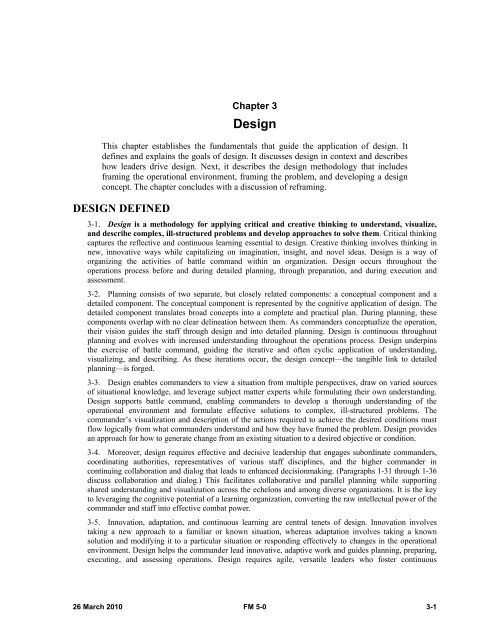FM 5-0, The Operations Process - Federation of American Scientists
FM 5-0, The Operations Process - Federation of American Scientists
FM 5-0, The Operations Process - Federation of American Scientists
You also want an ePaper? Increase the reach of your titles
YUMPU automatically turns print PDFs into web optimized ePapers that Google loves.
Chapter 3<br />
Design<br />
This chapter establishes the fundamentals that guide the application <strong>of</strong> design. It<br />
defines and explains the goals <strong>of</strong> design. It discusses design in context and describes<br />
how leaders drive design. Next, it describes the design methodology that includes<br />
framing the operational environment, framing the problem, and developing a design<br />
concept. <strong>The</strong> chapter concludes with a discussion <strong>of</strong> reframing.<br />
DESIGN DEFINED<br />
3-1. Design is a methodology for applying critical and creative thinking to understand, visualize,<br />
and describe complex, ill-structured problems and develop approaches to solve them. Critical thinking<br />
captures the reflective and continuous learning essential to design. Creative thinking involves thinking in<br />
new, innovative ways while capitalizing on imagination, insight, and novel ideas. Design is a way <strong>of</strong><br />
organizing the activities <strong>of</strong> battle command within an organization. Design occurs throughout the<br />
operations process before and during detailed planning, through preparation, and during execution and<br />
assessment.<br />
3-2. Planning consists <strong>of</strong> two separate, but closely related components: a conceptual component and a<br />
detailed component. <strong>The</strong> conceptual component is represented by the cognitive application <strong>of</strong> design. <strong>The</strong><br />
detailed component translates broad concepts into a complete and practical plan. During planning, these<br />
components overlap with no clear delineation between them. As commanders conceptualize the operation,<br />
their vision guides the staff through design and into detailed planning. Design is continuous throughout<br />
planning and evolves with increased understanding throughout the operations process. Design underpins<br />
the exercise <strong>of</strong> battle command, guiding the iterative and <strong>of</strong>ten cyclic application <strong>of</strong> understanding,<br />
visualizing, and describing. As these iterations occur, the design concept—the tangible link to detailed<br />
planning—is forged.<br />
3-3. Design enables commanders to view a situation from multiple perspectives, draw on varied sources<br />
<strong>of</strong> situational knowledge, and leverage subject matter experts while formulating their own understanding.<br />
Design supports battle command, enabling commanders to develop a thorough understanding <strong>of</strong> the<br />
operational environment and formulate effective solutions to complex, ill-structured problems. <strong>The</strong><br />
commander’s visualization and description <strong>of</strong> the actions required to achieve the desired conditions must<br />
flow logically from what commanders understand and how they have framed the problem. Design provides<br />
an approach for how to generate change from an existing situation to a desired objective or condition.<br />
3-4. Moreover, design requires effective and decisive leadership that engages subordinate commanders,<br />
coordinating authorities, representatives <strong>of</strong> various staff disciplines, and the higher commander in<br />
continuing collaboration and dialog that leads to enhanced decisionmaking. (Paragraphs 1-31 through 1-36<br />
discuss collaboration and dialog.) This facilitates collaborative and parallel planning while supporting<br />
shared understanding and visualization across the echelons and among diverse organizations. It is the key<br />
to leveraging the cognitive potential <strong>of</strong> a learning organization, converting the raw intellectual power <strong>of</strong> the<br />
commander and staff into effective combat power.<br />
3-5. Innovation, adaptation, and continuous learning are central tenets <strong>of</strong> design. Innovation involves<br />
taking a new approach to a familiar or known situation, whereas adaptation involves taking a known<br />
solution and modifying it to a particular situation or responding effectively to changes in the operational<br />
environment. Design helps the commander lead innovative, adaptive work and guides planning, preparing,<br />
executing, and assessing operations. Design requires agile, versatile leaders who foster continuous<br />
26 March 2010 <strong>FM</strong> 5-0 3-1















